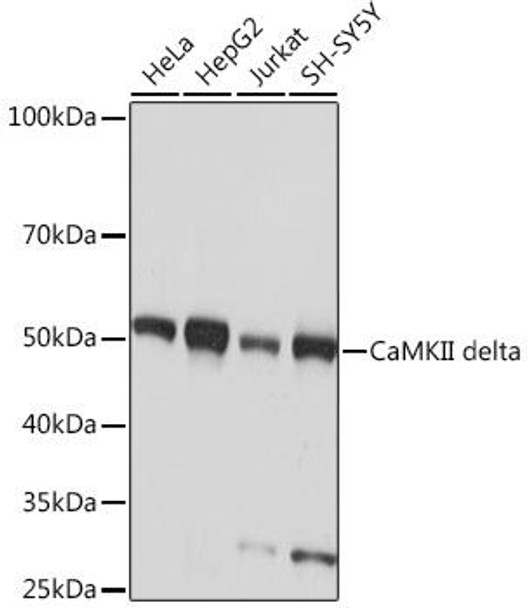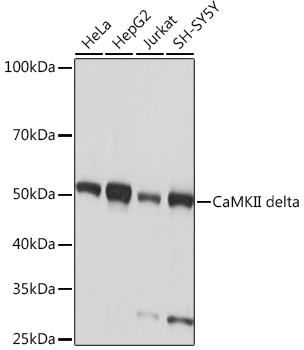Anti-CaMKII delta Antibody (CAB9196)
- SKU:
- CAB9196
- Product type:
- Antibody
- Reactivity:
- Human
- Mouse
- Rat
- Host Species:
- Rabbit
- Isotype:
- IgG
- Antibody Type:
- Monoclonal Antibody
- Research Area:
- Cell Biology
Description
| Antibody Name: | Anti-CaMKII delta Antibody |
| Antibody SKU: | CAB9196 |
| Antibody Size: | 20uL, 50uL, 100uL |
| Application: | WB IF |
| Reactivity: | Human, Mouse, Rat |
| Host Species: | Rabbit |
| Immunogen: | A synthesized peptide derived from human CaMKII delta |
| Application: | WB IF |
| Recommended Dilution: | WB 1:500 - 1:2000 IF 1:50 - 1:200 |
| Reactivity: | Human, Mouse, Rat |
| Positive Samples: | HeLa, HepG2, Jurkat, SH-SY5Y |
| Immunogen: | A synthesized peptide derived from human CaMKII delta |
| Purification Method: | Affinity purification |
| Storage Buffer: | Store at -20°C. Avoid freeze / thaw cycles. Buffer: PBS with 0.02% sodium azide, 0.05% BSA, 50% glycerol, pH7.3. |
| Isotype: | IgG |
| Sequence: | Email for sequence |
| Gene ID: | 817 |
| Uniprot: | Q13557 |
| Cellular Location: | |
| Calculated MW: | 50kDa |
| Observed MW: | 50KDa |
| Synonyms: | CAMKD |
| Background: | The product of this gene belongs to the serine/threonine protein kinase family and to the Ca(2+)/calmodulin-dependent protein kinase subfamily. Calcium signaling is crucial for several aspects of plasticity at glutamatergic synapses. In mammalian cells, the enzyme is composed of four different chains: alpha, beta, gamma, and delta. The product of this gene is a delta chain. Alternative splicing results in multiple transcript variants encoding distinct isoforms. Distinct isoforms of this chain have different expression patterns.[provided by RefSeq, Nov 2008] |
| UniProt Protein Function: | CAMK2D: a protein kinase of the calcium/calmodulin-dependent protein kinase (CAMK) group that interacts with the sarcoplasmic reticulum membrane in cardiac and skeletal muscle. Regulates Ca2+ homeostatis and excitation-contraction coupling (ECC) in heart. Calmodulin binding induces conformational changes that relieve autoinhibition, permitting autophosphorylation at T287, rendering the kinase constitutively active and independent of Ca2+-binding. Targets ion channels, transporters and accessory proteins involved in Ca2+ influx into the myocyte, Ca2+ release from the sarcoplasmic reticulum (SR), SR Ca2+ uptake and Na+ and K+ channel transport. Also targets transcription factors and signaling molecules to regulate heart function. In its activated form, is involved in the pathogenesis of dilated cardiomyopathy and heart failure. Contributes to cardiac decompensation and heart failure by regulating SR Ca2+ release via direct phosphorylation of RYR2 Ca2+ channel on S2808. In the nucleus, phosphorylates the MEF2 repressor HDAC4, promoting its nuclear export and binding to 14-3-3 protein, and expression of MEF2 and genes involved in the hypertrophic program. Is essential for left ventricular remodeling responses to myocardial infarction. In pathological myocardial remodeling acts downstream of the beta adrenergic receptor signaling cascade to regulate key proteins involved in ECC. Regulates Ca2+ influx to myocytes by binding and phosphorylating the L-type Ca2+ channel subunit beta-2 CACNB2. In addition to Ca2+ channels, can target and regulate the cardiac sarcolemmal Na+ channel SCN5A and the K+ channel Kv4.3, which contribute to arrhythmogenesis in heart failure. Phosphorylates phospholamban (PLB), an endogenous inhibitor of SERCA2A, contributing to the enhancement of SR Ca2+ uptake that may be important in frequency-dependent acceleration of relaxation (FDAR) and maintenance of contractile function during acidosis. May participate in the modulation of skeletal muscle function in response to exercise, by regulating SR Ca2+ transport through phosphorylation of PLB and TRDN, a ryanodine receptor-coupling factor. CAMK2 is composed of 4 different chains: alpha (CAMK2A), beta (CAMK2B), gamma (CAMK2G), and delta (CAMK2D). The different isoforms assemble into homo- or heteromultimeric holoenzymes composed of 12 subunits with two hexameric rings stacked one on top of the other. Interacts with RRAD and CACNB2. Ten isoforms of the human protein are produced by alternative splicing. Isoform Delta3, isoform Delta2, isoform Delta8 and isoform Delta9 are expressed in cardiac muscle. Isoform Delta11 is expressed in skeletal muscle. Activity is induced in skeletal muscle during exercise. The CAMK2 protein kinases contain a unique C-terminal subunit association domain responsible for oligomerization. |
| UniProt Protein Details: | Protein type:EC 2.7.11.17; Kinase, protein; Protein kinase, CAMK; Protein kinase, Ser/Thr (non-receptor); CAMK group; CAMK2 family Chromosomal Location of Human Ortholog: 4q26 Cellular Component: nucleoplasm; sarcoplasmic reticulum membrane; membrane; perinuclear region of cytoplasm; cytoplasm; plasma membrane; nucleus; cytosol; sarcolemma Molecular Function:calmodulin binding; sodium channel inhibitor activity; protein serine/threonine kinase activity; protein binding; protein homodimerization activity; calmodulin-dependent protein kinase activity; titin binding; nitric-oxide synthase binding; ATP binding Biological Process: positive regulation of smooth muscle cell proliferation; protein amino acid autophosphorylation; cytokine and chemokine mediated signaling pathway; peptidyl-threonine phosphorylation; positive regulation of smooth muscle cell migration; protein amino acid phosphorylation; cellular potassium ion homeostasis; regulation of heart contraction; protein oligomerization; regulation of transcription from RNA polymerase II promoter; positive regulation of Rac protein signal transduction; synaptic transmission; endoplasmic reticulum calcium ion homeostasis; peptidyl-serine phosphorylation; regulation of G2/M transition of mitotic cell cycle; response to hypoxia; regulation of cell growth; regulation of the force of heart contraction |
| NCBI Summary: | The product of this gene belongs to the serine/threonine protein kinase family and to the Ca(2+)/calmodulin-dependent protein kinase subfamily. Calcium signaling is crucial for several aspects of plasticity at glutamatergic synapses. In mammalian cells, the enzyme is composed of four different chains: alpha, beta, gamma, and delta. The product of this gene is a delta chain. Alternative splicing results in multiple transcript variants encoding distinct isoforms. Distinct isoforms of this chain have different expression patterns.[provided by RefSeq, Nov 2008] |
| UniProt Code: | Q13557 |
| NCBI GenInfo Identifier: | 116242602 |
| NCBI Gene ID: | 817 |
| NCBI Accession: | Q13557.3 |
| UniProt Secondary Accession: | Q13557,Q52PK4, Q59G21, Q8N553, Q9UGH6, Q9UQE9, A8MVS8 |
| UniProt Related Accession: | Q13557 |
| Molecular Weight: | 499 |
| NCBI Full Name: | Calcium/calmodulin-dependent protein kinase type II subunit delta |
| NCBI Synonym Full Names: | calcium/calmodulin-dependent protein kinase II delta |
| NCBI Official Symbol: | CAMK2D |
| NCBI Official Synonym Symbols: | CAMKD |
| NCBI Protein Information: | calcium/calmodulin-dependent protein kinase type II subunit delta; CaMK-II delta subunit; caMK-II subunit delta; CaM-kinase II delta chain; CaM kinase II delta subunit; caM kinase II subunit delta; calcium/calmodulin-dependent protein kinase type II delta |
| UniProt Protein Name: | Calcium/calmodulin-dependent protein kinase type II subunit delta |
| Protein Family: | Calcium/calmodulin-dependent protein kinase |
| UniProt Gene Name: | CAMK2D |
| UniProt Entry Name: | KCC2D_HUMAN |











![Anti-Delta-Catenin/p120 Catenin Antibody (CAB18043)[KO Validated] Anti-Delta-Catenin/p120 Catenin Antibody (CAB18043)[KO Validated]](https://cdn11.bigcommerce.com/s-39x6lpnvxv/images/stencil/590x590/products/27441/25630/anti-delta-cateninp120-catenin-antibody-cab18043ko-validated__06556__84974.1644314232.jpg?c=1)